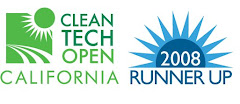 The Energy Policy Act of 2005 (EPACT 2005) provides tax incentives--rebates of $1.80 / SF--for commercial buildings that are designed to use 50% (or less) energy than typical code buildings as measured against ASHRAE 90.1-2001. (This is but one of the many existing and forthcoming local, state and federal incentives.)
The Energy Policy Act of 2005 (EPACT 2005) provides tax incentives--rebates of $1.80 / SF--for commercial buildings that are designed to use 50% (or less) energy than typical code buildings as measured against ASHRAE 90.1-2001. (This is but one of the many existing and forthcoming local, state and federal incentives.)Since ECAPT '05 went on the books (and as awareness grows that the pesky problem of global warming may be feedback-spiraling beyond redress), several trade and industry organizations have hitched their wagons and brought in new horsepower to help designers, contractors and building developers achieve the laudable goal of cutting building energy consumption in 1/2.
 In 2007, The New Buildings Institute organized and hosted the Getting to Fifty Summit of 60 experts within the fields of design and construction in order to network, strategize and develop concepts all aimed at accelerating the efficiency of commercial buildings. The detailed report of their conclusions and recommendations can be found here. Below is a quick synopsis of key takeaways:
In 2007, The New Buildings Institute organized and hosted the Getting to Fifty Summit of 60 experts within the fields of design and construction in order to network, strategize and develop concepts all aimed at accelerating the efficiency of commercial buildings. The detailed report of their conclusions and recommendations can be found here. Below is a quick synopsis of key takeaways:- It's critical to build the business case for high-performance buildings
- Early design process improvements can improve information, choices and adoption
- Plug-and-play integrated technology packages can capture the next step in efficiency for lighting and HVAC
- Climate-specific response design greatly increases efficiency
- Case studies and post-occupancy evaluations are key to reducing real and perceived risks
- Tax incentives and progressive codes / standards are essential
 Luckily for the planet and her advocates, there are many organizations working to reduce building energy consumption by 50%. The American Institute of Architects developed a program known as 50>>50: 50 Strategies toward 50% reduction in fossil fuel reduction in buildings. The strategies, or tools as they are referred to "span a spectrum from broad-based site and planning objectives to specific, building-based concepts." Essentially, the strategies create a handy toolkit of how-to resources for architects and construction folks and their ilk. Featured prominently, of course, GSHP, or Geoexchange as it is referred to in the colloquial.
Luckily for the planet and her advocates, there are many organizations working to reduce building energy consumption by 50%. The American Institute of Architects developed a program known as 50>>50: 50 Strategies toward 50% reduction in fossil fuel reduction in buildings. The strategies, or tools as they are referred to "span a spectrum from broad-based site and planning objectives to specific, building-based concepts." Essentially, the strategies create a handy toolkit of how-to resources for architects and construction folks and their ilk. Featured prominently, of course, GSHP, or Geoexchange as it is referred to in the colloquial. The 2030 Challenge, a program of Architecture 2030, is focused on reducing greenhouse gas (GHG) emissions and notes that 76% of all coal-fired juice is consumed by buildings. Thus, to turn the noxious smoke-belching titanic away from the (melting) iceberg, and to to slow and reverse GHG emission, the development industry must step it up and set its sights on these targets:
The 2030 Challenge, a program of Architecture 2030, is focused on reducing greenhouse gas (GHG) emissions and notes that 76% of all coal-fired juice is consumed by buildings. Thus, to turn the noxious smoke-belching titanic away from the (melting) iceberg, and to to slow and reverse GHG emission, the development industry must step it up and set its sights on these targets:- All new buildings, developments and major renovations shall be designed to meet a fossil fuel, GHG-emitting, energy consumption performance standard of 50% of the regional (or country) average for that building type.
- At a minimum, an equal amount of existing building area shall be renovated annually to meet a fossil fuel, GHG-emitting, energy consumption performance standard of 50% of the regional (or country) average for that building type.
- The fossil fuel reduction standard for all new buildings and major renovations shall be increased to:
60% in 2010
70% in 2015
80% in 2020
90% in 2025
Carbon-neutral in 2030 (using no fossil fuel GHG emitting energy to operate).







No comments:
Post a Comment